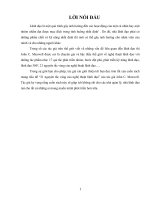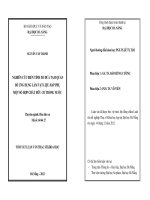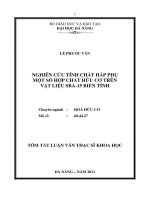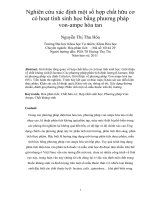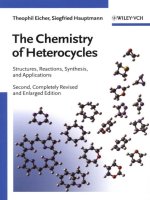The chemistry of heterocycles (second edition)
Bạn đang xem bản rút gọn của tài liệu. Xem và tải ngay bản đầy đủ của tài liệu tại đây (35.05 MB, 571 trang )
Theophil Eicher,
Siegfried
Hauptmann
The
Chemistry
of
Heterocycles
The
Chemistry ofHeterocycles,
Second
Edition.
By
Theophil Eicher
and
Siegfried Hauptmann
Copyright
©
2003 Wiiey-VCH Veriag GmbH
& Co.
KGaA
ISBN:
3-527-30720-6
Further Reading
from
Wiley-VCH
Fuhrhop,
J H.,
Li, G.
Organic
Synthesis,
3. Ed.
2003.3-527-30272-7 (Hardcover)
3-527-30273-5 (Softcover)
Schmalz,
H Q, Wirth,T. (Eds.)
Organic
Synthesis Highlights
V
2003.3-527-30611-0
Nicolaou,
K. C,
Snyder
S. A.
Classics
in
Total Synthesis
II
2003.3-527-30685-4 (Hardcover)
3-527-30684-6 (Softcover)
Green,
M. M.,
Wittcoff,
H. A.
Organic
Chemistry
Principles
and
Industrial
Practice
2003.3-527-30289-1
Theophil Eicher, Siegfried Hauptmann
in
Collaboration with Andreas Speicher
The
Chemistry
of
Heterocycles
Structure,
Reactions, Syntheses,
and
Applications
Second,
Completely
Revised,
and
Enlarged Edition
Translated
by
Hans
Suschitzky
and
Judith Suschitzky
WILEY-
VCH
WILEY-VCH
GmbH
& Co.
KGaA
Authors This
book
was
carefully
produced. Nevertheless,
Professor
Dr.
Theophil Eicher authors
and
publisher
do not
warrant
the
information
University
of the
Saarland contained therein
to be
free
of
errors.
Readers
are
Am
Botanischen Garten
1
advised
to
keep
in
mind that statements, data,
D-66123
Saarbrücken illustrations, procedural details
or
other items
may
Germany inadvertently
be
inaccurate.
Professor
Dr.
Siegfried
Hauptmann
Naunhofer
Strasse
137
D-04299 Leipzig
Library
of
Congress Card No.: applied
for
Germany British
Library
Cataloging-in-Publication Data:
PD Dr.
Andreas
Speicher
A
catalogue record
for
this book
is
available
from
the
Department
of
Chemistry British Library
University
of the
Saarland
D-66041
Saarbrücken
Germany Bibliographic information published
by
Die
Deutsche Bibliothek
Die
Deutsche Bibliothek lists this publication
in the
Translators
Deutsche Nationalbibliografie; detailed bibliographic
Professor
Dr.
Hans Suschitzky
and
Mrs. Judith
data
is
available
in the
Suschitzky
Internet
at
<>.
Department
of
Chemistry
and
Applied Chemistry
University
of
Salford
Salford
M5 4WT
United Kingdom
©
2003 WILEY-VCH
GmbH
& Co.
KGaA, Weinheim
All
rights reserved (including those
of
translation into
other languages).
No
part
of
this book
may be
repro-
duced
in any
form
- nor
transmitted
or
translated into
machine language without written permission
from
the
publishers. Registered names, trademarks, etc. used
in
this
book, even when
not
specifically marked
as
such,
are not to be
considered unprotected
by
law.
Printed
in the
Federal
Republic
of
Germany
Printed
on
acid-free paper
Printing
Strauss Offsetdruck
GmbH,
Mörlenbach
Bookbinding
Großbuchbinderei
J.
Schäffer
GmbH
&
Co. KG,
Grünstadt
ISBN 3-527-30720-6
Dedicated
to
Ursula
and
Gundela
VII
Foreword
The
heterocycles constitute
the
largest group
of
organic compounds
and are
becoming ever more
im-
portant
in all
aspects
of
pure
and
applied chemistry.
The
monograph,
The
Chemistry
of
Heterocycles
-
Structure,
Reactions,
Syntheses
and
Applications,
is a
comprehensive survey
of
this vast
field.
The
discussion
is
supported
by
numerous lucid diagrams
and the
extensive reaction schemes
are
supported
by
relevant
and
up-to-date references. Aromatic
and
nonaromatic heterocycles
are
treated according
to
increasing
ring
size under
six
defined
headings. Thus, information
can be
easily located
and
compared.
Natural occurance, synthetic
aspects,
as
well
as
modern applications
of
many heterocyclic compounds
in
the
chemical
and
pharmaceutical industries
are
also described.
This book will
no
doubt prove
to be an
invaluable reference source.
It is
eminently
for
advanced
un-
dergraduate
and
graduate students
of
chemistry,
and of
related subjects such
as
biochemistry
and me-
dicinal chemistry.
It
also provides
an
important
aid to
professional
chemists,
and
teachers
of
chemistry
will
find
it
most
useful
for
lecture preparation.
It
will surely
find a
place
on the
bookshelf
of
university
libraries
and in the
laboratories
of
scientists concerned with
any
aspect
of
heterocyclic chemistry.
Hans
Suschitzky,
University
ofSalford
IX
Preface
Of
the
more than
20
million chemical compounds currently registered, about
one
half contain hetero-
cyclic
systems. Heterocycles
are
important,
not
only because
of
their abundance,
but
above
all
because
of
their chemical, biological
and
technical significance. Heterocycles count among their number
many
natural
products, such
as
vitamins, hormones, antibiotics, alkaloids,
as
well
as
Pharmaceuticals, herbi-
cides, dyes,
and
other products
of
technical importance (corrosion inhibitors, antiaging drugs, sensitiz-
ers, stabilizing agents, etc.).
The
extraordinary
diversity
and
multiplicity
of
heterocycles
poses
a
dilemma: What
is to be
included
in
an
introductory book
on
heterocyclic chemistry which does
not aim to be an
encyclopaedia? This
difficulty
had to be
resolved
in a
somewhat arbitrary manner.
We
decided
to
treat
a
representative
cross section
of
heterocyclic
ring
systems
in a
conventional arrangement.
For
these heterocycles,
structural,
physical
and
spectroscopic features
are
described,
and
important chemical properties, reac-
tions
and
syntheses
are
discussed. Synthesis
is
consequently approached
as a
retrosynthetic problem
for
each heterocycle,
and is
followed
by
selected derivatives, natural products, Pharmaceuticals
and
other
biologically active compounds
of
related structure type,
and is
concluded
by
aspects
of the use in
synthesis
and in
selected synthetic transformations.
The
informations given
are
supported
by
refer-
ences
to
recent primary literature, reviews
and
books
on
experimental chemistry. Finally,
a
section
of
"problems"
and
their solutions
-
selected
in a
broad variety
and
taken mainly
from
the
current litera-
ture
-
intends
to
deepen
and to
extend
the
topics
of
heterocyclic chemistry presented
in
this book.
The
book
is
designed
for the
advanced student
and
research worker,
and
also
for the
industrial
chemist looking
for a
survey
of
well-tried fundamental
concepts
as
well
as for
information
on
modern
developments
in
heterocyclic chemistry.
The
contents
of
this book
can
also serve
as a
basis
for the
design
of
courses
in
heterocyclic chemistry. Above all, however,
we
intend
to
demonstrate that general
chemical
principles
of
structure, reactivity
and
synthesis
can be
elucidated
by
using examples
from
the
chemistry
of
heterocycles.
Text
and
diagrams were produced with
the
Word
for
Windows
and
ChemWindow packages,
re-
spectively,
in the
Desktop Publishing program.
We
are
indebted
to
Prof.
Dr. H.
Becker, Prof.
Dr. R. W.
Hartmann, Prof.
Dr. U.
Kazmaier
and
Prof.
Dr. L. F.
Tietze
for
valuable advice
and
encouragement. Special thanks
are due to
Mrs.
Ch.
Altmeyer
for
her
excellent
assistance
and
cooperativeness
in
preparing
the
camera-ready version
of
this book.
We
also thank
Dr. E.
Westermann
and the
staff
of the
editorial
office
of
Wiley
VCH for
their collabo-
ration
and
understanding.
Saarbrücken
and
Leipzig,
April 2003
Theophil
Eicher Siegfried Hauptmann
XI
Contents
Abbreviations
and
Symbols
XV
1 The
Structure
of
Heterocyclic Compounds
1
2
Systematic
Nomenclature
of
Heterocyclic Compounds
5
2.1
Hantzsch-Widman Nomenclature
6
2.2
Replacement Nomenclature
11
2.3
Examples
of
Systematic Nomenclature
12
2.4
Important Heterocyclic Systems
16
3
Three-Membered Heterocycles
17
3.1
Oxirane
17
3.2
Thiirane
24
3.3
2#-Azirine
26
3.4
Aziridine
28
3.5
Dioxirane
32
3.6
Oxaziridine
32
3.7
3#-Diazirine
34
3.8
Diaziridine
35
References
37
4
Four-Membered Heterocycles
38
4.1
Oxetane
38
4.2
Thietane
41
4.3
Azete
42
4.4
Azetidine
43
4.5
1,2-Dioxetane
45
4.6
1,2-Dithiete
48
4.7
l,2-Dihydro-l,2-diazete
48
4.8
1,2-Diazetidine
49
References
51
XII
Contents
5
Five-Membered Heterocycles
52
5.1
Furan
52
5.2
Benzo[6]furan
63
5.3
Isobenzofuran
65
5.4
Dibenzofuran
66
5.5
Tetrahydrofuran
67
5.6
Thiophene
71
5.7
Benzo[&]thiophene
80
5.8
Benzo[c]thiophene
82
5.9
2,5-Dihydrothiophene
83
5.10
Thiolane
84
5.11 Selenophene
85
5.12 Pyrrole
86
5.13
Indole
99
5.14 Isoindole
110
5.15
Carbazole
111
5.16
Pyrrolidine
114
5.17
Phosphole
116
5.18
1,3-Dioxolane
118
5.19 1,2-Dithiole
119
5.20
1,2-Dithiolane
120
5.21 1,3-Dithiole
121
5.22
1,3-Dithiolane
122
5.23
Oxazole
122
5.24
Benzoxazole
132
5.25
4,5-Dihydrooxazole
134
5.26 Isoxazole
138
5.27 4,5-Dihydroisoxazole
144
5.28 2,3-Dihydroisoxazole
147
5.29 Thiazole
149
5.30
Benzothiazole
155
5.31
Penam
159
5.32 Isothiazole
160
5.33 Imidazole
165
5.34 Benzimidazole
174
5.35
Imidazolidine
178
5.36 Pyrazole
179
5.37 Indazole
185
Contents
XIII
5.38 4,5-Dihydropyrazole
186
5.39
Pyrazolidine
189
5.40
1,2,3-Oxadiazole
191
5.41
1,2,5-Oxadiazole
193
5.42 1,2,3-Thiadiazole
196
5.43
1,2,4-Thiadiazole
198
5.44
1,2,3-Triazole
200
5.45 Benzotriazole
205
5.46 1,2,4-Triazole
208
5.47 Tetrazole
212
References
218
6
Six-Membered
Heterocycles
222
6.1
Pyryliumion
222
6.2
2//-Pyran
231
6.3
27/-Pyran-2-one
233
6.4
3,4-Dihydro-2//-pyran
239
6.5
Tetrahydropyran
243
6.6
2tf-Chromene
245
6.7
2//-Chromen-2-one
247
6.8
1-Benzopyrylium
ion 252
6.9
4//-Pyran
255
6.10 4//-Pyran-4-one
257
6.11
4#-Chromene
260
6.12
4#-Chromen-4-one
261
6.13
Chroman
266
6.14
Pyridine
269
6.15 Pyridone
310
6.16 Quinoline
316
6.17 Isoquinoline
336
6.18 Quinolizinium
ion 349
6.19
Dibenzopyridines
353
6.20 Piperidine
360
6.21
Phosphabenzene
365
6.22
1,4-Dioxin, 1,4-Dithiin, 1,4-Oxathiin
369
6.23
1,4-Dioxane
371
6.24
Oxazine
373
6.25
Morpholine
381
6.26 1,3-Dioxane
383
XIV
Contents
6.27 1,3-Dithiane
387
6.28
Cepham
389
6.29
Pyridazine
392
6.30 Pyrimidine
398
6.31 Purine
408
6.32
Pyrazine
417
6.33 Piperazine
422
6.34 Pteridine
425
6.35
Benzodiazine
430
6.36 1,2,3-Triazine
437
6.37 1,2,4-Triazine
440
6.38 1,3,5-Triazine
446
6.39 1,2,4,5-Tetrazine
451
References
457
7
Seven-Membered Heterocycles
461
7.1
Oxepine
461
7.2
Thiepine
465
7.3
Azepine
466
7.4
Diazepines
472
References
478
8
Larger Ring Heterocycles
480
8.1
Azocine
480
8.2
Heteronines
and
Larger Ring Heterocycles
482
8.3
Tetrapyrroles
485
References
494
9
Problems
and
Their Solutions
496
10
Indices
545
10.1
General
Subject
Index
545
10.2 Index
of
Named Reactions
554
XV
Abbreviations
and
Symbols
mp
melting point
de
diastereoisomeric excess
bp
boiling
point
%
percentage
ca.
circa
°C
degrees centigrade
cf.
compare
A
thermal
cf.
p see
page
h v
photochemical
MO
molecular orbital
dil
dilute
INN
international nonproprietary name coned concentrated
IR
infrared
spectrum ref. reference
cm*
1
wave number A//* activation enthalpy
(kJ
moH)
UV
ultraviolet spectrum rfl. heated under
reflux
A
wavelength r.t. room temperature
e
molar extinction
coefficient
et al. and
other authors
1
H NMR
proton
resonance
spectrum
nm
nanometer
(10~
9
m)
13
CNMR
13
C
resonance spectrum
pm
picometer (10-
12
m)
S
chemical
shift
(ÖTMS
=
0)
ppm
parts
per
million
(10'
6
)
ee
enantiomeric excess
Ac
acetyl
Ar
aryl
Boc ter/-butoxycarbonyl
Bn
benzyl
Bz
benzoyl
n-Bu «-butyl
sec-Bu sec-butyl
tert-Bu
tert-butyl
Et
ethyl
Me
methyl
Mes
mesyl (methanesulfonyl)
Ph
phenyl
/-Pr
isopropyl
H-Pr
w-propyl
Tos
tosyl (p-toluenesulfonyl)
The
Chemistry
ofHeterocycles,
Second
Edition.
By
Theophil Eicher
and
Siegfried Hauptmann
Copyright
©
2003
Wiley-VCH Verlag GmbH
& Co.
KGaA
ISBN:
3-527-30720-6
XVI
Abbreviations
and
Symbols
DABCO
1,4-diazabicyclo[2.2.2]octane
DMF
dimethylformamide
DMSO
dimethyl sulfoxide
DDQ
2,3-dichloro-5,6-dicyano-l,4-benzoquinone
DBU
l,8-diazabicyclo[5.4.0]undec-7-ene
HMPT
hexamethylphosphoric triamide
LDA
lithiumdiisopropylamide
LiTMP
lithium-2,2,6,6-tetramethylpiperidide
MOM
methoxymethyl
NBS
7V-bromosuccinimide
NCS
7V-chlorosuccinimide
PPA
polyphosphoric acid
TBAF
tetra-w-butylammonium
fluoride
THF
tetrahydrofiiran
TMEDA
A^^TV'^^tetramethylethylenediamine
IMS
trimethylsilyl
TosMIC (p-toluenesulfonyl)methylisocyanide
1
The
Structure
of
Heterocyclic Compounds
Most
chemical compounds consist
of
molecules.
The
classification
of
such chemical compounds
is
based
on the
structure
of
these molecules, which
is
defined
by the
type
and
number
of
atoms
as
well
as
by
the
covalent bonding within them. There
are two
main types
of
structure:
—
The
atoms
form
a
chain
-
aliphatic (acyclic) compounds
—
The
atoms
form
a
ring
-
cyclic compounds
Cyclic
compounds
in
which
the ring is
made
up of
atoms
of one
element only
are
called isocyclic com-
pounds.
If the
ring
consists
of
C-atoms only, then
we
speak
of a
carbocyclic compound, e.g.:
NMe?
O
(4
-
dimethylaminophenyl)
pentazole
cyclopenta
-1,3
-
diene
isocyclic
isocyclic
und
carbocyclic
Cyclic
compounds with
at
least
two
different
atoms
in the
ring
(as
ring atoms
or
members
of the
ring)
are
known
as
heterocyclic compounds.
The
ring itself
is
called
a
heterocycle.
If the
ring contains
no
C-atom,
then
we
speak
of an
inorganic heterocycle, e.g.:
MeO
2,4
- bis (4 -
methoxyphenyl)
-
1,3
-
dithiadiphosphetan
-2,4
-
disulfide
borazine
(Lawesson
-
Reagent)
If
at
least
one
ring atom
is a
C-atom, then
the
molecule
is an
organic heterocyclic compound.
In
this
case,
all the
ring atoms which
are not
carbon
are
called heteroatoms, e.g.:
The
Chemistry
ofHeterocycles, Second Edition.
By
Theophil
Eicher
and
Siegfried
Hauptmann
Copyright
©
2003
Wiiey-VCH
Veriag
GmbH
& Co.
KGaA
ISBN:
3-527-30720-6
The
Structure
of
Heterocyclic
Compounds
oxazole
4 - H
-1,4
-
thiazine
heteroatoms
O and N
heteroatoms
S and N
In
principle,
all
elements except
the
alkali metals
can act as
ring atoms.
Along
with
the
type
of
ring atoms, their total number
is
important since this determines
the
ring size.
The
smallest possible ring
is
three-membered.
The
most important
rings are the
five-
and
six-
membered
heterocycles. There
is no
upper limit; there exist seven-, eight-, nine-
and
larger-membered
heterocycles.
Although
inorganic heterocycles have been synthesized,
this
book limits itself
to
organic com-
pounds.
In
these,
the
N-atom
is the
most common heteroatom. Next
in
importance
are O- and
S-atoms.
Heterocycles
with Se-, Te-,
P-,
As-, Sb-, Bi-, Si-, Ge-, Sn-,
Pb- or
B-atoms
are
less common.
To
determine
the
stability
and
reactivity
of
heterocyclic compounds,
it is
useful
to
compare them
with their carbocyclic analogues.
In
principle,
it is
possible
to
derive every heterocycle
from
a
carbo-
cyclic
compound
by
replacing appropriate
CH
2
or CH
groups
by
heteroatoms.
If one
limits oneself
to
monocyclic
systems,
one can
distinguish
four
types
of
heterocycles
as
follows:
•
Saturated heterocycles
(heterocycloalkanes),
e.g.:
C
cyclohexane
X = O
oxane
X = O
1,4-dioxane
X
= S
thiane
X = S
1,4-dithiane
X
= NH
piperidine
X = NH
piperazine
In
this category, there
are no
multiple bonds between
the
ring atoms.
The
compounds react largely like
their aliphatic analogues, e.g. oxane (tetrahydropyran)
and
dioxane behave like dialkyl
ethers,
thiane
and
1,4-dithiane like dialkyl
sulfides,
and
piperidine
and
piperazine like secondary aliphatic amines.
Partially
unsaturatedsystems
(heterocycloalkenes)',
e.g.:
O
cyclohexene
X = O
3,4-dihydro-2H-pyran
X
= S
X
= NH
The
Structure
of
Heterocyclic Compounds
0
X
= O
3,4-dJhydro-1,4-dioxin
X = O®
X=S
X=S®
X
= NH X = NH
2,3,4,5-tetrahydropyridine
If
the
multiple bonds
are
between
two
C-atoms
of the
ring,
as, for
instance,
in
3,4-dihydro-2//-pyran,
the
compounds react essentially like alkenes
or
alkynes.
The
heteroatom
can
also
be
involved
in a
dou-
ble
bond.
In the
case
of X = O
+
, the
compounds behave like oxenium salts,
in the
case
of X = S
+
,
like
sulfenium
salts,
and in the
case
of X = N,
like imines (azomethines).
•
Systems
with
the
greatest possible number
of
noncumulated
double bonds (heteroannulenes), e.g.:
[6]annulene
X = O®
pyryliumsalts
X = N
pyrimidine
benzene
X = S®
thiiniumsalts
X
= N
py
rid
ine,
pyridine-like
N -
atom
o
X
= 0
furan
X
= S
thiophene
X
= NH
pyrrole,
pyrrole-like
N -
atom
[8]annulene
X = cP X = N 1,3 -
diazocine
cyclooctatetraene
X = S
X
= N
azocine
.
X
= 0
oxepine
X
= S
thiepine
X
= NH
azepine
The
Structure
of
Heterocyclic Compounds
From
the
annulenes,
one can
formally
derive
two
types
of
heterocycles:
—
systems
of the
same ring size,
if CH is
replaced
by X
—
systems
of the
next lower ring size,
if
HC=CH
is
replaced
by X.
In
both cases,
the
resulting heterocycles
are
iso-^-electronic with
the
corresponding annulenes, i.e.
the
number
of
^-electrons
in the
ring
is the
same. This
is
because
in the
pyrylium
and
thiinium salts,
as
well
as in
pyridine, pyrimidine, azocine
and
1,3-diazocine, each heteroatom donates
one
electron pair
to the
conjugated system
and its
nonbonding electron pair does
not
contribute. However, with
furan,
thiophene, pyrrole, oxepin, thiepin
and
azepine,
one
electron pair
of the
heteroatom
is
incorporated into
the
conjugated system (delocalization
of the
electrons). Where nitrogen
is the
heteroatom, this
differ-
ence
can be
expressed
by the
designation pyridine-like N-atom
Qr
pyrrole-like N-atom.
•
Heteroaromatic systems
This includes heteroannulenes, which comply with
the
HÜCKEL rule, i.e. which possess
(4n + 2)
^•-electrons
delocalized over
the ring. The
most important group
of
these compounds derives
from
[6]annulene
(benzene). They
are
known
as
heteroarenes, e.g.
furan,
thiophene, pyrrole, pyridine,
and
the
pyrylium
and
thiinium ions.
As
regards stability
and
reactivity, they
can be
compared
to the
corre-
sponding benzenoid compounds [1].
The
antiaromatic systems, i.e. systems possessing
4n
delocalized electrons, e.g. oxepin, azepine, thi-
epin,
azocine,
and
1,3-diazocine,
as
well
as the
corresponding annulenes, are,
by
contrast, much less
stable
and
very reactive.
The
classification
of
heterocycles
as
heterocycloalkanes, heterocycloalkenes, heteroannulenes
and
heteroaromatics allows
an
estimation
of
their stability
and
reactivity.
In
some cases, this
can
also
be
applied
to
inorganic
heterocycles.
For
instance, borazine (see
p 1), a
colourless
liquid,
bp
55°C,
is
clas-
sified
as a
heteroaromatic system.
[1] P. v.
Rague Schleyer,
H.
Jiao, Pure AppL Chem. 1996,
68,
209;
Chem.Rev.
2001,707, 1115;
C.
W.
Bird, Tetrahedron 1998,
54,
10179;
T. M.
Krygowski,
M. K.
Cyranski,
Z.
Czarnocki,
G.
Häfelinger,
A.
R.
Katritzky, Tetrahedron 2000,
56,
1783.
2
Systematic Nomenclature
of
Heterocyclic Com-
pounds
Many
organic compounds, including heterocyclic compounds, have
a
trivial name. This usually origi-
nates
from
the
compounds occurrence,
its
first
preparation
or its
special properties.
Structure
Trivial
name
Systematic
name
O
/ \
ethylene oxide oxirane
pyromucic acid furan
- 2 -
carboxylic acid
.COOH
nicotinic acid pyridine
- 3 -
carboxylic acid
2H
-
chromen
- 2 - one
The
derivation
of the
systematic name
of a
heterocyclic compound
is
based
on its
structure. Nomencla-
ture rules have been drawn
up by the
IUPAC Commission
and
these should
be
applied when writing
theses, dissertations, publications
and
patents. These rules
are
listed
in
section
R-2 of the
most recent
IUPAC
'Blue
Book'
together with worked examples (H.R.Panico, W.H.Powell, J C.Richer
A
Guide
to
IUPAC
Nomenclature
of
Organic Compounds, Recommendations 1993; Blackwell Scientific: Oxford,
1993;
the
previous IUPAC Blue Book: J.Rigandy, S.P.Klesney Nomenclature
of
Organic
Chemistry;
Pergamon:
Oxford, 1979).
The
IUPAC rules
are not
given
in
detail here, rather instructions
are
given
for
formulating systematic
names with appropriate reference
to the
Blue Book.
Every heterocyclic compound
can be
referred back
to a
parent ring system. These systems have only
H-atoms attached
to the ring
atoms.
The
IUPAC rules allow
two
nomenclatures.
The
Hantzsch-
Widman
nomenclature
is
recommended
for
three-
to
ten-membered heterocycles.
For
larger ring het-
erocycles, replacement nomenclature should
be
used.
The
Chemistry
of
Heterocycles,
Second
Edition.
By
Theophil
Eicher
and
Siegfried
Hauptmann
Copyright
©
2003
Wiiey-VCH
Veriag
GmbH
& Co.
KGaA
ISBN:
3-527-30720-6
Systematic
Nomenclature
of
Heterocyclic Compounds
2.1
Hantzsch-Widman Nomenclature
•
Type
ofheteroatom
The
type
of
heteroatom
is
indicated
by a
prefix
according
to
Table
1. The
sequence
in
this table also
indicates
the
preferred order
of
prefixes
(principle
of
deer
easing
priority).
Table
1
Prefixes
to
indicate heteroatoms
Element
0
S
Se
Te
N
P
As
Prefix
oxa
thia
selena
tellura
aza
phospha
arsa
Element
r Sb
Bi
Si
Ge
Sn
Pb
B
Hg
Prefix
stiba
bisma
sila
germa
stanna
plumba
bora
mercura
•
Ring size
The ring
size
is
indicated
by a
suffix
according
to
Table
2.
Some
of the
syllables
are
derived
from
Latin
numerals,
namely
ir
from
tri,
et
from
tetra,
ep
from
hepta,
oc
from
octa,
on
from
nona,
ec
from
deca.
Table
2
Stems
to
indicate
the
ring size
of
heterocycies
Ring
Size
3
4
5
6A
C
6B
C
6C
C
7
8
9
10
a
The
stem
b
The
traditi
Unsaturated Saturated
Irene
2
ete
ole
ine
ine
inine
epine
ocine
onine
ecine
irine
may be
used
ional
stems 'irine
1
.
irane
b
etane
b
olane
b
ane
inane
inane
epane
ocane
onane
ecane
for
rings containing only
N.
'etidine'
and
'olidine'
are
oreferred
for
N-coi
saturated heteromonocycles having three, four
or
five ring members, respectively.
The
stem
for
six-membered
rings
depends
on the
least preferred heteroatom
in the
ring,
that
immediately
preceding
the
stem.
To
detemine
the
correct stem
for a
structure,
the set
below containing this least-
preferred heteroatom
is
selected.
6A: O, S, Se, Te, Bi, Hg; 6B: N, Si, Ge, N, Pb; 6C: B, P, As, Sb
2.1
Hantzsch-Widman
Nomenclature
•
Monocydic systems
The
compound with
the
maximum number
of
noncumulative double bonds
is
regarded
as the
parent
compound
of the
monocyclic systems
of a
given
ring
size.
The
naming
is
carried
out by
combining
one
or
more prefixes
from
Table
1
with
a
suffix
from
Table
2. If two
vowels
succeed
one
another,
the
letter
a
is
omitted
from
the
prefix,
e.g. azirine (not azairine).
H M
azirine azete pyrrole pyridine azepine azocine
Note that trivial names
are
permitted
for
some systems, e.g. pyrrole, pyridine. Permitted trivial names
can
be
found
in the
latest IUPAC Blue Book
pp
166-172;
if a
trivial name
is
permitted then
it
should
be
used.
Partly
or
completely saturated rings
are
denoted
by the
suffixes
according
to
Table
2. If no
ending
is
specified
the
prefixes dihydro-, tetrahydro-, etc. should
be
used.
2,3-dihydropyrrole pyrrolidine
1,4 -
dihydropyridine
piperidine
(hexahydropyridine)
•
Monocyclic systems,
one
heteroatom
The
numbering
of
such systems starts
at the
heteroatom.
•
Monocyclic systems,
two or
more identical heteroatoms
The
prefixes di-, tri-, tetra-, etc.,
are
used
for two or
more heteroatoms
of the
same kind. When indicat-
ing
the
relative positions
of the
heteroatoms,
the
principle
of the
lowest possible numbering
is
used, i.e.
the
numbering
of the
system
has to be
carried
out in
such
a way
that
the
heteroatoms
are
given
the
low-
est
possible
set of
locants:
1,2,4
-
triazole (not 1,3,5 -triazole)
pyrimidine
(1,3
-
diazine,
not 1,5 -
diazine)
In
such
a
numerical sequence,
the
earlier numbers take precedence, e.g. 1,2,5
is
lower than 1,3,4.
8 2
Systematic Nomenclature
of
Heterocycllc Compounds
•
Monocyclic systems,
two or
more
different
heteroatoms
For
heteroatoms
of
different
kinds, prefixes
are
used
in the
order
in
which they appear
in
Table
1,
e.g.
thiazole,
not
azathiole; dithiazine,
not
azadithiine.
The
heteroatom highest
in
Table
1 is
allocated
the 1-
position
in the ring. The
remaining heteroatoms
are
assigned
the
smallest possible
set of
number
lo-
cants:
s
thiazole
isothiazole
1,4,2
-
dithiazine
(1,3-thiazole)
(1,2-thiazole)
Although
in the
first
example
the
systematic name
is
1,3-thiazole,
the
locants
are
generally omitted
because, except
for
isothiazole (1,2-thiazole),
no
other structural isomers exist. Similar rules apply
to
oxazole (1,3-oxazole)
and
isoxazole (1,2-oxazole).
•
Identical systems connected
by a
single bond
Such
compounds
are
defined
by the
prefixes bi-, tert-, quater-, etc., according
to the
number
of
sys-
tems,
and the
bonding
is
indicated
as
follows:
2,2'
-
bipyridine
2,2': 4',3"
-
terthiophene
•
Bicyclic systems with
one
benzene ring
Systems
in
which
at
least
two
neighbouring atoms
are
common
to two or
more rings
are
known
as
fused
systems.
For
several bicyclic benzo-fused heterocycles, trivial names
are
permitted, e.g.:
indole
quinoline
isoquinoline
If
this
is not the
case,
and
only
the
heterocycle
has a
trivial name, then
the
systematic name
is
formu-
lated
from
the
prefix benzo-
and the
trivial name
of the
heterocyclic component
as
follows:
benzo
[b]
furan
f
uran
2.1
Hantzsch-Widman
Nomenclature
The
system
is
dissected
into
its
components.
The
heterocyclic component
is
regarded
as the
base com-
ponent.
The
bonds between
the ring
atoms
are
denoted according
to the
successive numbers
of the
ring
atoms
by the
letters
a, b, c,
etc.
The
letter
b in
brackets between
benzo
and the
name
of the
base com-
ponent
denotes
the
atoms
of the
base component which
are
common
to
both rings.
The
letter must
be
as
early
as
possible alphabetically
and
hence
benzo[c/]furan
is
incorrect.
It
is
generally accepted that
the
numbering
of the
whole system
in the
case
of bi- and
also polycyclic
systems should
be
done independently
of the
numbering
of the
components,
and as
follows:
The
ring system
is
projected onto rectangular coordinates
in
such
a way
that
— as
many rings
as
possible
lie in a
horizontal
row
— a
maximum number
of rings are in the
upper right quadrant.
The
system thus oriented
is
then numbered
in a
clockwise direction commencing with that atom which
is not
engaged
in the
ring
fusion
and is
furthest
to the
left
— in the
uppermost ring
or
— in the
ring
furthest
to the
right
in the
upper row.
C-Atoms
which belong
to
more than
one
ring
are
omitted. Heteroatoms
in
such positions are, however,
included.
If
there
are
several
possible
orientations
in the
coordinate system,
the one in
which
the
het-
eroatoms bear
the
lowest locants
is
valid:
If
the
base component does
not
have
a
trivial name,
the
entire system
is
numbered
as
explained above
and
the
resulting positions
of the
heteroatoms
are
placed
before
the
prefix
benzo:
1,2,4
-
benzodithiazine
3,1 -
benzoxazepine
• Bi-
and
polycyclic systems
-with
two or
more heterocycles
First
the
base component
is
established.
To
this
end the
criteria
in the
order
set out
below
are
applied,
one
by
one,
to
arrive
at a
decision.
The
base component
is
— a
nitrogen-containing component
— a
component with
a
heteroatom,
other than nitrogen, which
is as
high
as
possible
in
Table
1
— a
component with
as
many rings
as
possible (e.g. bicyclic condensed systems
or
polycyclic systems
which have trivial names)
— the
component with
the
largest ring
— the
component with most heteroatoms
— the
component with
the
largest number
of
heteroatoms
of
different
kinds
— the
component with
the
greatest number
of
heteroatoms which
are
highest
in
Table
1
— the
component with heteroatoms which have
the
lowest locant numbers.
10
2
Systematic Nomenclature
of
Heterocyclic Compounds
Two
isomers
are
given
as an
example:
pyrido[2,3
- d]
pyrimidine pyrido[3,2
- dj
pyrimidine
First,
the
system
is
dissected into
its
components.
The
base component cannot
be
established until
the
fifth
criterion
has
been reached: pyrimidine.
The
bonds between
the
ring atoms
are
marked
by
consecu-
tive lettering according
to the
serial numbering
of the
base component.
In
contrast
to the
example
on p
9,
the
fused
component must also
be
numbered, always observing
the
principle
of
assignment
to the
lowest possible locants.
The
name
of the
fused
component,
by the
replacement
of the
terminal
V
with
'o',
is put
before
the
name
of the
base component.
The
atoms common
to
both rings
are
described
by
numbers
and
letters
in
square brackets, wherein
the
sequence
of the
numbers must correspond
to the
direction
of the
lettering
of the
base component.
Finally
the
whole system
is
numbered.
•
Indicated hydrogen
In
some cases, heterocyclic systems occur
as one or
more structural isomers which
differ
only
in the
position
of an
H-atom. These isomers
are
designated
by
indicating
the
number corresponding
to the
position
of the
hydrogen atom
in
front
of the
name,
followed
by an
italic capital
H.
Such
a
prominent
H-atom
is
called
an
indicated hydrogen
and
must
be
assigned
the
lowest possible locant.
/PiV
p~\
V V
O
^
H
pyrro
l
e
2H -
pyrrole
3,4 -
dihydro -2H- pyrrole
(not
5H -
pyrrole) (not4,5-dihydro-3H-pyrrole
or A
1
pyrroline)
The
name pyrrole implies
the 1
-position
for the
H-atom.
Heterocyclic compounds
in
which
a
C-atom
of the
ring
is
part
of a
carbonyl group
are
named with
the aid of
indicated hydrogen
as
follows:
phosphinin-2-(1 H)-one pyrazin-2(3H)-one
11
2.2
Replacement Nomenclature
•
Monocyclic systems
The
type
of
heteroatom
is
indicated
by a
prefix
according
to
Table
1. As all
prefixes
end
with
the
letter
a,
replacement nomenclature
is
also known
as 'a'
nomenclature. Position
and
prefix
for
each heteroa-
tom are
written
in
front
of the
name
of the
corresponding hydrocarbon. This
is
derived
from
the
het-
erocyclic
system
by
replacing every heteroatom
by
CH
2
,
CH or C:
H
2
ö
silacyclopenta-2,4-diene cyclopentadiene 1-thia-4-aza-2-silacyclohexane cyclohexane
Sequence
and
numbering
of the
heteroatoms
follow
the
rules given
in
2.1.
The two
compounds chosen
as
examples could also
be
named according
to the
Hantzsch-Widman
system: silole, 1,4,2-
thiazasilane.
• Bi-
and
poly
cyclic
systems
Again, position
and
prefix
are put in
front
of the
name
of the
corresponding hydrocarbon,
but the
num-
bering
of
the
hydrocarbon
is
retained:
3,9
-
diazaphenanthrene phenanthrene
7 -
oxabicyclo 2.2.1 heptane bicyclo 2.2.1
heptan«
The
Hantzsch-Widman nomenclature
can
only
be
applied
to the first
example
and
this then results
in
different
numbering.
pyrido[4,3
-
c]quinoline


